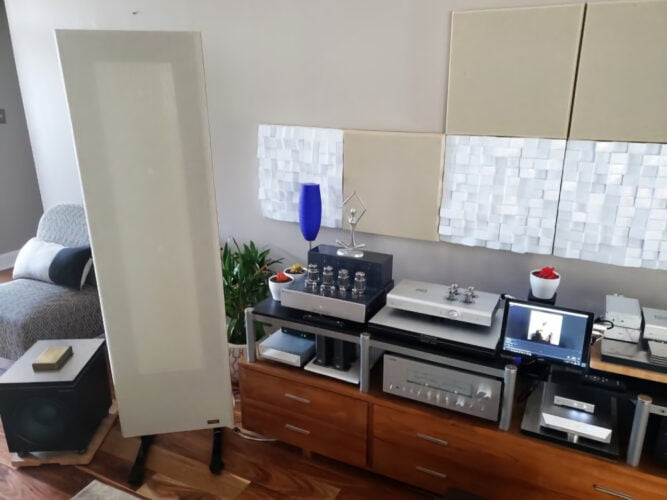-By Jan A. (audiocircle.com).
Having an opportunity to have three different amplifiers in my system, I thought sharing my impressions would assist or inform anyone considering NuPrime ST-10M/ Magnepan combination.

System – Source – NuPrime DAC-10 – miniDSP – power amplifier – Magnepan 1.7i; 2x B&W ASW610 subs are connected line level from miniDSP crossed at 40 Hz (Butterworth 36db filter). DSP runs Dirac Live 2.0 room correction algorithm up to 250 Hz only. Single-Ended (RCA) connections used throughout.
Source Digital – WD NAS/ Tidal streaming – ACER Switch 5 running ROON server – NuPrime DAC-10 (USB) or Yamaha CD-S1000 – NuPrime DAC-10 (SPDIF); ROON DSP set to upsample to DSD256 with “smooth linear” filter.
Source Analog – Ortofon Quintet Black S/ Soundsmith Zephyr MIMC Star ES – Rega RP8/RB808 – Graham Slee Elevator EXP/ Reflex M PSU1 – NuPrime DAC-10
Listening space – 28’x16’x9.5′ (recessed to 11′); speakers are 9′ apart, 11′ from the listening position, 3′ from the front wall; the room is treated with the combination of diffusers/absorbers and several frequency transducers. The room is tuned to be more lively than neutral.
Auxiliaries – Cables – interconnect and speaker BlueJeans (copper) or Stager Sound (silver) – power cables Gotham UltraShield – USB iFi Gemini3
Auxiliaries – Vibration control – Simposium Acoustic Platforms/Rollerblocks for equipment and MagnaRisers for the speakers
Power amplifiers (non NuPrime amps shall remain nameless)
– NuPrime ST-10M (TDSS mod) MSRP $3,200
– MOSFET A-A/B (MOSAB), 150W/4 Ohm per channel, MSRP $7,000
– Tube KT-120 (TKT120), 36W/20W UL/TR mode per channel, MSRP $4,500

Soundstaging – This is what I am addicted to, so I’ll start with it. By far, ST10M presents to the listener the deepest and most holographic soundstage. The front wall disappears (sonically); however, the soundstage is limited to the speaker boundaries on most recordings. The impression of the space in which recording was made is very tangible, real, and well preserved. One can clearly and easily distinguish the size of the recording space, be it church, concert hall, or small club. Sound of music also scales appropriately with the recording space. The MOSAB, in turn, has wider soundstage but is somewhat flat and, therefore, less tri-dimensional presentation. The strange thing, the front wall is still a sonic boundary, but now side walls disappear. Who said that all amplifiers sound the same? TKT120 is somewhere in between, maybe closer to the ST-10M signature. Flößt, mein Heiland from Kathleen Battle’s album Grace perfectly illustrates points I am making. The extremely light and delicate sound of the oboe and her voice lit up recording space, while continuo section of baroque organ and cello provide anchor point (top right and back) for the whole performance. Another record showing of ST10M soundstaging prowess is Little Feat’s Waiting for Columbus, my favorite live rock recording. From the intro, just before “join the band” singing one can hear various band members talking and singing, moving through the narrow passage towards the backstage after which the soundstage opens up wide, the crowd is heard from all sides and “The Fat Man in the Bathtub” starts. This is what I mean by addictive; the ST10M makes me believe I am in that very space of the music performance. I have to mention here that if I connect ST10M to the speakers, ignoring the fact that this is phase inverting amp, soundstage collapsed appreciatively. I don’t know what possessed the NuPrime engineering team to design it this way. Maybe some audio demon?
Imaging and definition – Magnepans are not exactly imaging champions, but despite that, both ST10M and MOSAB localize instruments and performers quite well. With ST10M, these phantom images are very stable and easy to localize within the soundstage. However, MOSAB has an edge in this aspect of the sound, I think, due to its superior resolution that I’ll mention later. However, what ST10M does better is the scale of these images. All instruments (and vocalists) are portrayed appropriately to their size, although Magnepans are allegedly prone to exaggerate this (maybe another myth). In my listening, two pieces show ST10M imaging abilities at their best. First is Rutter’s Requiem. Chorals in Requiem Aeternam from this magnificent work are properly placed within the soundstage, voice types identifiable not only from left to right but in-depth as well. Once instruments and the organ enter, ST10M excels over MOSAB. Second is Ralph Towner’s Nimbus from Solstice. Imaging of the Towner’s guitar virtuoso from the opening of the song as well as Weber’s bass wailing, allows the listener to “see” individual strings as fingers or a bow has engaged them. So, where does TKT120 fit in the imaging department? Trios, quartets, small jazz ensembles, in particular, chamber jazz and single female or male vocals are best sounding through TKT120. By the best I mean they are most real, sonic images have a more definite shape, maybe because with tubes, they are moved slightly forward. Midrange tube magic is not a myth, for sure.
Frequency extension, balance, and refinement – MOSAB has best extension out of three. Noticeable in HF, where one can hear more detail (by comparison) without HF being particularly emphasized. Clarity is also remarkable at mid-bass (40-80 Hz). For example, finger plucking, string, and body reverb of the upright bass are separate sounds through MOSAB. In fact, it sounds in mid-bass like traditional class-D amplifiers often well described in the media. The balance within full frequency range is what one can describe as neutral (everything is even, no tilt, no dip from 20Hz-20kHz) but for my ears not necessarily natural (the way live music sounds). The MOSAB is perfect for analytical listening, which some prefer and also very capable of evaluating other components in the signal chain. On the other hand, ST10M, although lacking in the ultimate HF extension, is much more natural sounding. Instruments like guitars, woodwind instruments sound just perfect. Different natures of these amplifiers are shown while listening to Anuar Brahem on The Astounding Eyes of Rita. While MOSAB gives insight into every note of the performance, including valve movement on Gesing’s bass clarinet, which is very appropriate, and if I dare say exciting, ST10M presents that same clarinet as a real full-bodied instrument. I am not suggesting ST10M lacks resolution here, or that clarinet does not sound real through MOSAB, but only that ST10M rounds all the aspects of the instrument into one whole better. Again TKT120 fits somewhere in between the two. It does not roll-off HF, and it portrays music very well, maybe slightly emphasizing midrange, however in a pleasing sense. More so, of course, in a TR mode. Nice for a low volume level night listening.
Few words on the LF sound. Extention and work below 40 Hz are taken care of by active subs, so it is irrelevant for this discussion. I have already mentioned that MOSAB sounds like a traditional class-D amplifier, which is a good thing indeed. The ST10M also has very good mid-bass, but with the slightly more body to it. More lavish without being bloated or boomy, which suits my taste better than ultra-detailed sound MOSAB gives out. In all other aspects of mid-bass performance like slam, transients “speed,” etc. both amplifiers are on the same level. TKT120, on the other hand, has a somewhat boomy bass. It does not control the Magnepan bass panel as well as the other two.
As far as refinement is concerned, none of the amplifiers sound bright at the HF. The ST10M is more smooth than MOSAB but not as smooth as TKT120. By smooth, I do not mean resolution or frequency extension but a measure of “roundness” in the sound of cymbals, for example. TKT120 is very smooth with superior air in the HF; MOSAB is very detailed with “sharper” edges but not brittle sounding, and ST10M is more natural, e.g., its HF sounds are closer to sounds of the real, let’s say cymbals, but not lacking much in frequency extension. I cannot say one is better than the other, just different, and I must point out that these differences are minimal.
Tonality and pitch – I have touched on this above. The ST10M is the most tonally correct of the three amplifiers, with pitch-perfect bass notes. TKT120 is not trailing far behind except for mid-bass. Tubes are a mixed bag for me, accurately representing instruments after mid-bass frequencies, single vocals exceptionally well. On the other hand, MOSAB has so much detail that I have never heard in the live performance or when playing myself. I can see how this can be very attractive for some listeners. To sum up this section, ST10M has more presence and aliveness of the three, I believe, because of this accurate representation of the instruments and recording space. A good example of this tonal perception ST10M presents is Calypso Minor from Abdullah Ibrahim/Ekaya album Sotho Blue. Double Bass notes are clear and distinct, with just enough “meat” to make you think the instrument is playing right inside your room. Similarly, the brass section and piano are a pleasure to listen to. There is nothing artificial about this sound
Dynamics and power delivery – Word about Magnepans. At least in this “i” iteration, there is no question that speakers (with or without the subs) are capable of loading the room with dramatic impact, irrespective of the type of music one is playing…providing one has enough power/current on tap. I listen to the music at about 65-70 dB SPL with peaks reaching 85-90 dB SPL. Unfortunately 320W/4 Ohms ST10M “falls apart” at 85 dB, there is simply not enough “juice” to drive the speakers. Interestingly, this is the same point where 36W TKT120 also falters. 150W/4 Ohm MOSAB has no issues whatsoever driving Magnepans to insane levels and remains unphased; therefore, it cannot be matched by the other two in dynamic range and impact. It shows you that just looking at the published power ratings doesn’t inform one if the amp can drive hungry speakers like Magnepans. This is a pity as ST10M is a wonderfully sounding amp, matching well with Magnepan 1.7i up to a point described. Sound is so good and addictive it draws the listener deep into the music, I would say on an emotional level, that one just wants to push the volume up and up and up…and then 85 dB comes along and spoils the party
General comments about ST10M. The amplifier has attractive looks (mine is in silver), elegant without being just a plain box shape. The power LED in front is visible but nicely muted, so it is not a bother in the dark listening room. All the connections at the back are easily accessible, and everything works as it should. Two minor gripes I have with ST10M are cheap and brittle plastic on the speaker binding posts (comparing to ST10, this is a downgrade) and plastic feet with a thin rubbery washer. Seriously NuPrime? (Note from Nuprime: these are Eichmann binding posts with better performance than those on ST-10) Otherwise, amplifiers run cool and are very, very quiet. There is no mechanical hum from the transformer, and no noise is coming from the speaker when music is not playing, even listening through my other pair of speakers that have very sensitive ribbon tweeter.
In conclusion, ST10M is a reference level amplifier, just like advertised, in performance at least equal in many respects to the equipment that is multiple of their price level, which is saying something about NuPrime engineering abilities. I would still heartily recommend it pairing with Magnepans if you listen to the music at moderate levels (up to 85 dB SPL peaks) or having a smaller listening space.
I wish you all the best and keep safe.
Jan A. (audiocircle.com)

